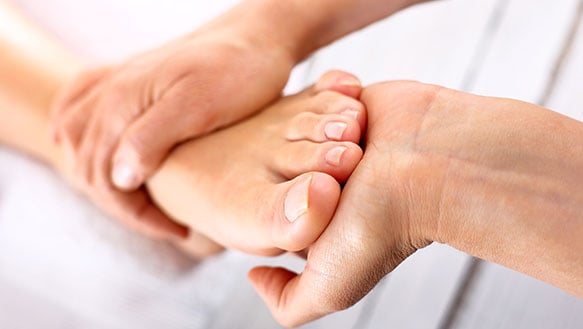
Pain and numbness or tingling in your legs and feet should be not be taken lightly as this can be one of the first signs or symptoms that someone with diabetes may experience. Medically referred to as “Diabetic Neuropathy”, pain and numbness can be a sign of nerve damage that can occur as a complication of both uncontrolled type 1 and type 2 diabetes.
While nerve fibers anywhere in the body can be damaged by uncontrolled blood glucose control, diabetic neuropathy most often affects the nerves in both your feet and legs. Read on how diabetic neuropathy (pain and numbness) can be an alarming sign of undiagnosed diabetes.
Contents
What Causes Pain and Numbness to Occur Due to Diabetes?
Depending on the location of the nerves affected by diabetic neuropathy, the symptoms of it can range from pain and numbness, most often in lower extremities to issues with your heart, digestive system, blood vessels and urinary tract.
Diabetic Neuropathy is the most common complication that can arise from uncontrolled and undiagnosed diabetes. However, the progression of this complication can be slowed by tightening blood glucose control.
Understanding How Pain and Numbness Can Be a Symptom of Diabetes
Uncontrolled diabetes, both type 1 and type 2, can lead to the progression of diabetic neuropathy. Those who develop symptoms of pain and numbness typically have a difficult time controlling their blood glucose levels, such as those who may not have yet realized they have diabetes (undiagnosed). This can also be caused from improper control of blood pressure levels, body weight and cholesterol levels as well in collaboration with higher blood glucose levels.
Recognizing the Signs and Symptoms
There are a few different types of diabetic neuropathy that can occur in those with both type 1 and type 2 diabetes. This is where recognizing the signs and symptoms may become a little challenging. The specific types include:
- Autonomic Neuropathy: It impairs your digestive system, causing it to function improperly. This can result in constipation, diarrhea or even an impaired bladder. Most commonly, it can cause you to have changes in the way you perspire and even have an effect on your sex drive. For men, this may cause a decrease in sexual arousal and erection challenges. Women may notice they are experiencing more vaginal dryness than usual.One thing to watch out for with autonomic neuropathy is that it can also mask the symptoms of low blood sugar, hypoglycemia.
- Focal Neuropathy: FN doesn’t discriminate, it will attack any nerve in the body and cause a sudden onset of weakness.
- Peripheral Neuropathy: PN is one of the more common types of neuropathy that occurs with those who have diabetes. This can cause numbness and even pain in your feet, arms, hands, toes and leg
- Proximal Neuropathy: Proximal neuropathy can cause weakness to occur in your hips, butt, thighs and legs.
Diagnosing pain and numbness
Because neuropathy caused by diabetes can cause a large variety of symptoms, there isn’t one key test or diagnostic tool to help a doctor diagnose you with the condition. They will relay greatly on doing a complete exam along with the description of your symptoms to help diagnose the condition.
Some tests doctors can use to help diagnose the condition are as follows:
- Nerve conduction study
- Heart rate variability test
- Ultrasound
I recommend reading the following articles:
What Increases the Risk of Pain and Numbness
Virtually anyone who has diabetes, both type 1 or type 2, can develop pain and numbness. But the following risk factors can increase your chances of developing the condition:
- How Long You’ve Had Diabetes: The risk increases the longer you have diabetes. You are at an even greater risk if your blood glucose control during this time has been uncontrolled.
- Being Overweight: Having a BMI above 24 can increase your risk.
- Poor Control of Blood Glucose Numbers: One of the biggest risk factors is having poor blood glucose control. Keeping your blood glucose numbers within a target range is important for decreasing your risk of most complications but especially diabetic neuropathy.
- Kidney Disease: Diabetes causes damage to your kidneys which in turn will increase the number of toxins in your blood and contribute to a higher than normal risk of nerve damage.
- Smoking: Smoking can decrease the space in your arteries as well as harden them. The narrowing of your arteries can decrease the flow of blood to your legs and feet. This can make it much more challenging for wounds to heal including any damage to your peripheral nerves.
Long Term Complications Associated with Pain and Numbness
Not dealing with treating your situation can increase your chances of developing many serious complications which include:
- Charcot Joint: This condition is marked with a loss of sensation in your joints, most commonly the foot because it deteriorates due to nerve damage. Swelling, instability and even deformity in the joint can occur. Early treatment is important because it can promote much healthier healing and prevent any future damage.
- Hypoglycemic Unawareness: Hypoglycemia happens when your blood glucose levels drop below a certain number typically 70 mg/dL. When hypoglycemic unawareness occurs, you dont feel your body dropping to these dangerously low levels, which can be potentially fatal if a low blood glucose level is not treated in a timely manner.
- Digestive Issues: Nerve damage that occurs in the digestive region can cause severe complications such as diarrhea, constipation or alternating bouts of both. Neuropathy can also lead to an increased risk of developing a condition called gastroparesis. Gastroparesis is when the stomach empties very slowly or doesn’t empty at all. This can cause interference with your digestion and lead to vomiting, bloating, nausea, malnutrition and unmanaged blood glucose levels.
- Urinary Tract Infections or Incontinence: Damage to the nerves which control your bladder can cause it to empty slowly or not quite completely. This will allow bacteria to enter your bladder or kidneys which can lead to urinary tract infections and even kidney infections. Nerve damage can also affect your body’s ability for you to feel when it’s time to urinate, leading to incontinence.
- Sexual Dysfunction: Autonomic Neuropathy causes damage to the nerves that control your sex organs. This can lead to erectile dysfunction in me as well as problems in arousal or lubrication in women.
- Increase or Decrease Sweating: When the glands that control sweating don’t work properly because of nerve damage, the body cannot regulate its temperature correctly. The complete lack of the body to perspire can be life-threatening if not treated promptly. Nerve damage in this area can also lead to an increase in sweating which can be embarrassing at times.
How to Decrease the Risk and Treatment of Pain and Numbness
You can prevent or decrease the risks and any complications that come with neuropathy, but first keeping your blood glucose levels within your target range and well controlled is the most important step. Following a healthy diabetic lifestyle consists of the following to help decrease your risk:
Blood Glucose Control
Keeping your levels within a tight controlled target range will require constant monitoring while taking all prescriptions properly, including insulin if needed. Keeping your levels within a controlled target range is one of the best ways you can prevent and decrease your risk of developing neuropathy as well as other diabetic complications. Consistency in your blood glucose levels is important because any shift or change in these levels can increase and even accelerate the rate that nerve damage may occur.
The American Diabetes Association recommends people to make sure they have an A1c test done at least 2 to 3 times a year to find out what their overall average blood glucose levels are for the past few months. If your control isn’t quite where it needs to be, speak with your diabetic care team and doctor to determine if a change in medications or treatment plan is necessary.
Your doctor can help to determine what the best target range for your blood glucose levels should be based on a few different factors such as age, length of diagnosis, health, and other medical conditions. But a common ‘controlled’ range of blood glucose levels with those with both type 1 and type 2 diabetes is:
- Between 80 to 120 or 4.4 to 6.7 for those age 59 and younger that have not other medical conditions.
- Between 100 to 140 or 5.6 to 7.8 for those age 60 and older with other underlying conditions such as lung, kidney and heart disease.
To slow progression it is recommended that you do the following consistently:
- Follow all recommendations from your doctor for both blood glucose control and preventative foot care
- Keep blood pressure levels within a healthy range
- Follow a good eating plan
- Get up and active with a frequent physical exercise
- Quit smoking
- Avoid any alcohol or only drink in moderation
- Maintain a heathy weight level
Treatment for Relieving Pain
There are many different medications available that can help to relieve nerve pain, but it is important to check with your doctor as they are always effective for everyone. The side effects of the medication must be compared to the overall benefits. This is something your doctor can help to determine for you.
Alternative treatment therapies include capsaicin cream, acupuncture, chiropractic care, and physical therapy. These treatments are often used in collaboration with other traditional treatments such as medication.
Pain relieving medications for pain and numbness can include:
- Anti-Seizure medications: Such as gabapentin (Neurotin), pregabalin (lyrica) and Carbamazepin (Carbatrol).
- Antidepressants: Antidepressants such as desipramine (norpramin) and imipramine (tofranil) can help with some nerve pain management, but they also increase your risk of side effects such as weight gain, dry mouth, constipation and dizziness.
- Some SNRIs such as duloxetine (Cymbalta) may relieve nerve pain but they also present increased side effects such as insomnia, fatigue, dizziness, decreased appetite, lightning or ice pick headaches and nausea.
Caring for Your Feet
Foot problems are one of the biggest complaints among those with type 1 or type 2 diabetes. This includes sores that don’t heal properly, ulcers and unfortunately, sometimes leading to amputation. You can prevent and decrease your risk of this happening by making sure you get a complete foot exam from a podiatrist at least one a year along with checking your feet frequently at home. To help protect your feet do the following:
- Check Daily: Look for any cuts, bruises, peeling, red skin, swelling and blisters. Use a mirror if you cannot see or ask someone to help examine those hard to see regions.
- Keep Feet Clean and Dry. Wash your feet properly each day with soap and water. Dry them between the toes but blotting them with a soft towel.
- Moisturize your feet after to prevent any dryness and cracking from occurring. Don’t get lotion between your toes this can lead to an increase in fungal growth.
FAQs
Are there other causes of pain and numbness besides diabetes?
While poorly controlled diabetes is one of the most common causes of pain and numbness, there are other conditions that can lead to the increased risk of developing the condition including:
- Alcoholism
- Vitamin Deficiency
- Shingles
- Kidney Failure
- Certain medications
- AIDS
- Autoimmune conditions such as Lupus, RA, Gillian Barre syndrome
- Inherited Disorders Like Amyloid Polyneuropathy
When should I contact my doctor?
Prompt and proper treatment is important when it comes to reducing the symptoms of pain and numbness. If you notice any changes in the sensations of your hands, feet, legs and arms, you may want to speak with your doctor immediately to determine the cause and avoid any drastic measures which can happen if you wait too long.
Can I cause permanent damage if I don’t treat it?
Early detection and prompt treatment are the main ways to prevent any further damage. Keeping your blood glucose levels within your target range is also very important as part of your treatment plan. Its important to develop this plan with the help of your doctor or diabetic care team and not to do any type of prevention on your own without their consent.
How common are they with people with diabetes?
Pain and numbness or neuropathy is one of the most common complications in those with both type 1 and type 2 diabetes. This is why keeping your blood glucose levels within the discussed target range your doctor has included in your management plan is extremely important.
Further articles:
- What is Exogenous Insulin?
- Double Diabetes: Is It A Myth or Does It Exist?
- Medtronic Continuous Glucose Monitoring with the Elite Sensor Review
- Closed Loop Systems: Future Treatment for Diabetes?
- 13 Amazing Management Tips for Adults Living with Type 2 Diabetes
- Diabetes and Fatigue: Everything You Need To Know
Conclusion
It’s important, first and foremost, to discuss with your doctor if you feel you are experiencing any symptoms associated with pain and numbness or diabetic neuropathy. They can help to determine if in fact this is the condition you have and how to proceed with treatment. Keeping your blood glucose levels within your target range is your first line of defense when it comes to preventing the condition from occurring in the first place. If you have any comments post them below and share this article with anyone who might benefit it from it.
TheDiabetesCouncil Article | Reviewed by Dr. Jerry Ramos MD on May 20, 2020
References
- http://www.diabetesforecast.org/2010/apr/what-can-i-do-for-numb-painful-feet-and-legs.html?referrer=https://www.google.com/
- https://www.everydayhealth.com/type-2-diabetes/why-does-type-2-diabetes-feet-go-numb/
- https://www.diabetesselfmanagement.com/blog/healing-numb-feet/
- https://www.webmd.com/brain/nerve-pain-and-nerve-damage-symptoms-and-causes#1











